
EXTRAS
All my sidequests
SYSTEM/TECHNICAL DESIGN


Machinations
I started learning Machinations when it was introduced during class. At first, I found it quite boring to be honest, but as I continued using it regularly, I began to see its potential. Over time, I realized it’s a powerful tool for bringing ideas to life and can be extremely helpful during the implementation phase.
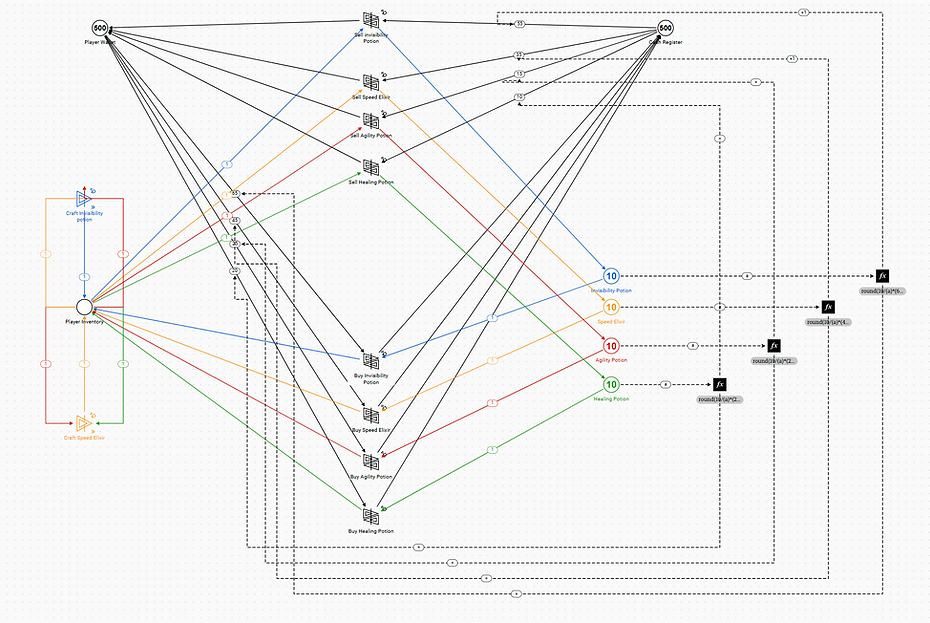
This system represents a potion item shop built using Machinations.io. It showcases a core loop where players can buy potions at fixed prices and sell them back at a lower rate. I created that with a built-in loss margin so that it encourages strategic resource management.
SYSTEM OVERVIEW
The system features four potions types:
-
Invisibility Potion
-
Agility Potion
-
Healing Potion
-
Speed Elixir
Players can interact with potions through three primary actions:
-
Buying potions by spending gold from the wallet.
-
Selling potions from the inventory for a reduced price, gaining back some gold.
-
Crafting Invisibility potion and Speed elixir using the required potions in the inventory.
All transactions affect the gold flow between the player's wallet and the register, simulating a realistic in-game marketplace.
DESIGN INTENT
The intentional price gap creates a realistic economy that:
-
Prevents profit farming by flipping potions.
-
Encourages players to only buy what they need.
-
Reinforces decision-making around crafting vs. purchasing.
-
Allows potion value to reflect rarity and gameplay usefulness.
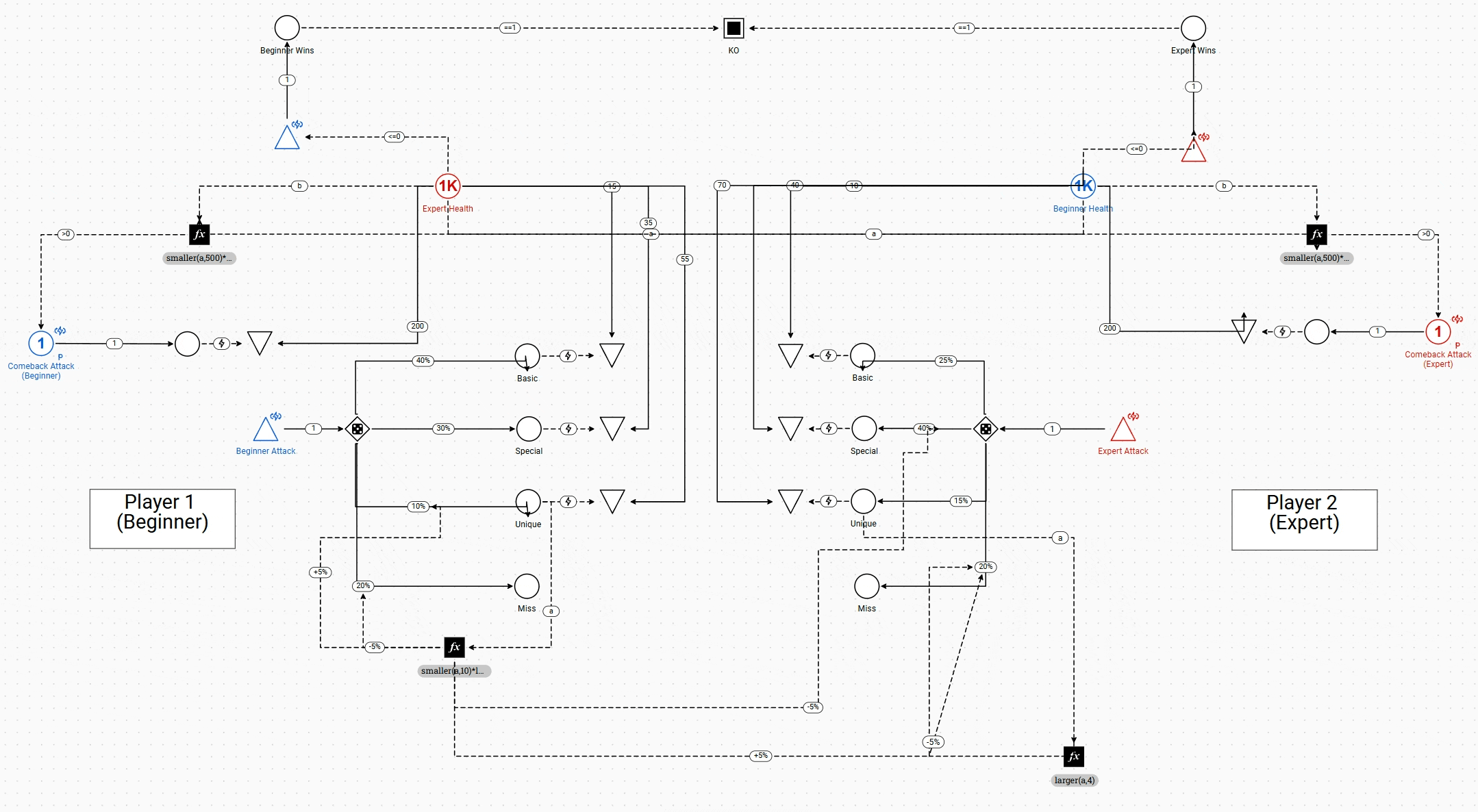
This diagram represents a fighting game combat system where O simulate an encounter between two players: Player 1 (Beginner) and Player 2 (Expert). The core objective of this model is to test and balance combat, comeback mechanics and probability-based attack outcomes.
SYSTEM OVERVIEW
-
Both players start with 1,000 HP (Expert Health and Beginner Health) and take turns attacking each other.
-
Each attack goes through a probabilistic node to determine the type of attack: Basic, Special, Unique, or Miss.
-
The damage values and hit probabilities differ slightly between the beginner and expert to simulate skill level.
DESIGN INTENT
-
Player 1 (Beginner) has:
-
Slightly higher chance to miss (20%) and slightly lower chance for a Unique attack.
-
A comeback mechanic that activates when their HP drops below 500, providing a stronger attack to help balance the game and simulate fairness for newcomers.
-
-
Player 2 (Expert):
-
Has more consistent attack probabilities (lower chance to miss).
-
Also gains access to a comeback mechanic if their HP drops below 500
-
BALANCING CONSIDERATION
-
I used random probabilities and dynamic conditions (smaller(a,500), larger(a,4), etc.) to simulate health-dependent triggers and introduce strategic layers.
-
This system is ideal for balancing early-stage combat mechanics in PvP or PvE scenarios, especially where difficulty scaling and player fairness are important.


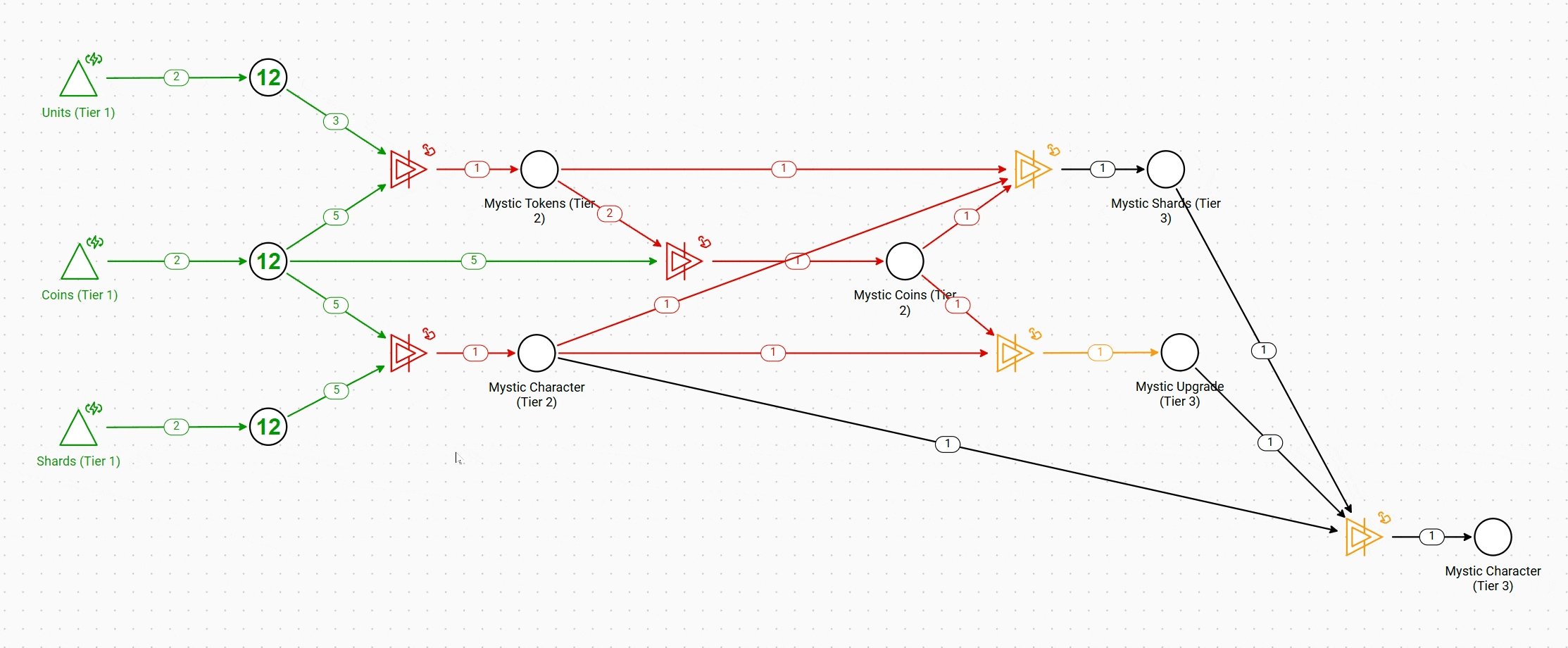

This diagram represents a mystic character progression and upgrade system for a game where players convert basic resources into higher-tier characters and upgrades. The system emphasizes resource crafting, tier-based upgrades and strategic planning.
SYSTEM OVERVIEW
The progression revolves around converting Tier 1 resources (Units, Coins, Shards) into a powerful Mystic Character (Tier 3) through multiple crafting and upgrade stages.
-
Tier 1: Players collect Units, Coins, and Shards.
-
Tier 2: These are converted into Mystic Tokens, Coins, and Characters.
-
Tier 3: Players craft Mystic Shards and Mystic Upgrades.
- Finally, all Tier 3 items are combined to create a Mystic Character (Tier 3).

DESIGN INTENT
-
Tier 3 characters require a significant investment, preventing early-game overpowering and ensuring a meaningful grind.
-
Players can prioritize which Tier 2 components to focus on depending on their playstyle or what they have in abundance.
-
Each tier and conversion step can be visualized as a crafting UI, with clear indicators of what's missing for efficient crafting.


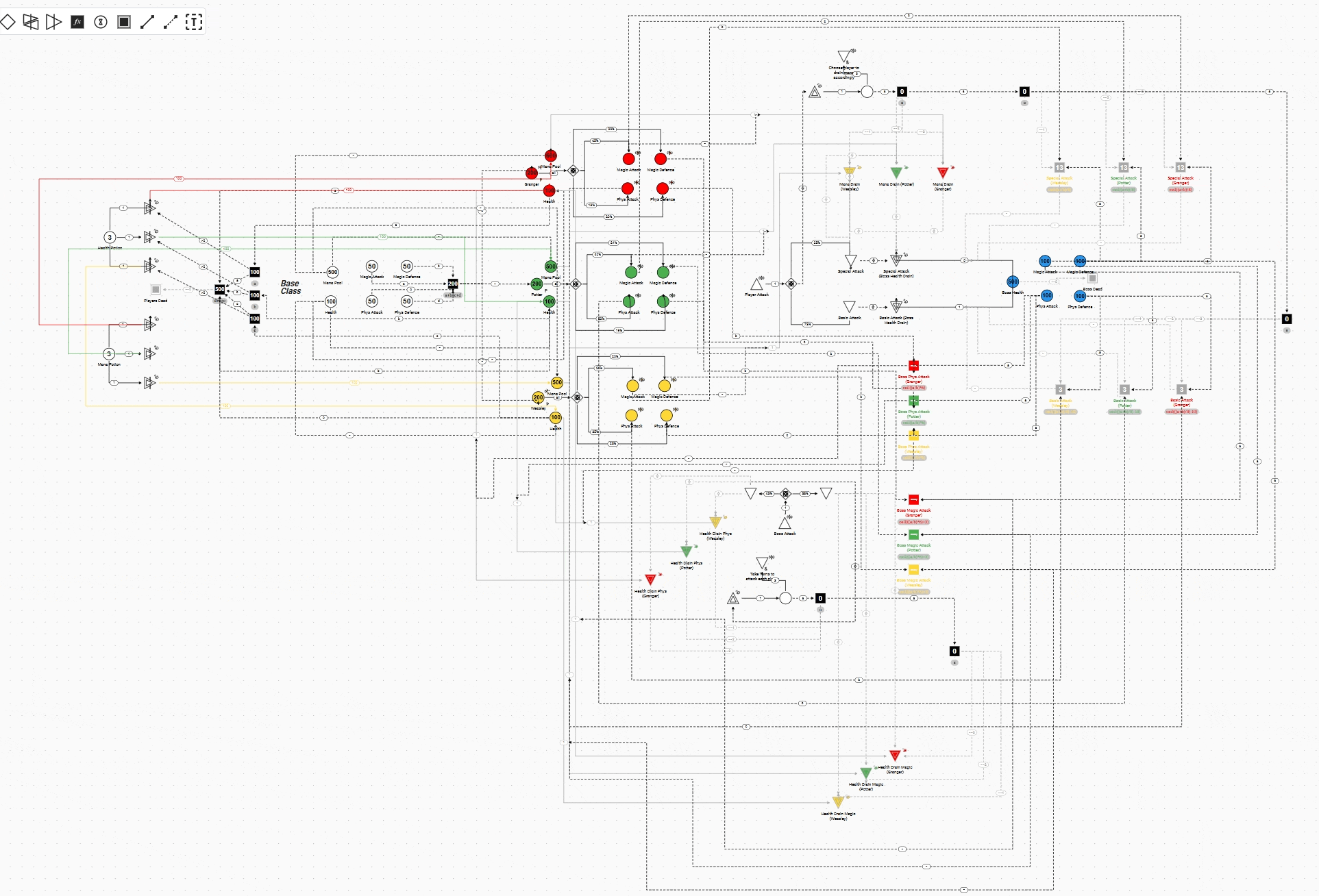
This Machination is a Boss encounter that I worked on for my final assignment in the systems design class. There are three players, Potter, Granger and Weasley, who face off against a boss.
PLAYERS
-
Each player is an instance of a Base Class that has some core attributes:
-
Health: 100
-
Mana: 500
-
Stats: Magic Attack, Magic Defence, Physical Attack, Physical Defence
-
-
Each player has access to:
-
Basic Attacks
-
Special Attacks
-
-
Each player has unique damage values and attribute values.
-
Based on probability, it is decided which player will attack. Also, the mana is drained based on the attack used.
-
Every Successful attack triggers a drain node that subtracts health from the boss or the players.
BOSS:
-
The boss has no mana pool, but has a large health pool (750 HP)
-
Has its own attributes of magic and physical attack/defence.
-
Responds with counterattack based on probability and trigger events.
DESIGN INTENT
-
The design encourages a cooperative strategy:
-
Granger focuses on magical attacks.
-
Weasley has better physical attack and defence, and hence may act as a semi-tank.
-
Potter has balanced stats, hence can fill multiple roles.
-
-
It also balances resource usage, where players need to manage mana by deciding to use basic and special attacks.
Documentation
Hitman Security Guard AI Behaviour Tree
Cool!! Let's move on to Behaviour tree's and now
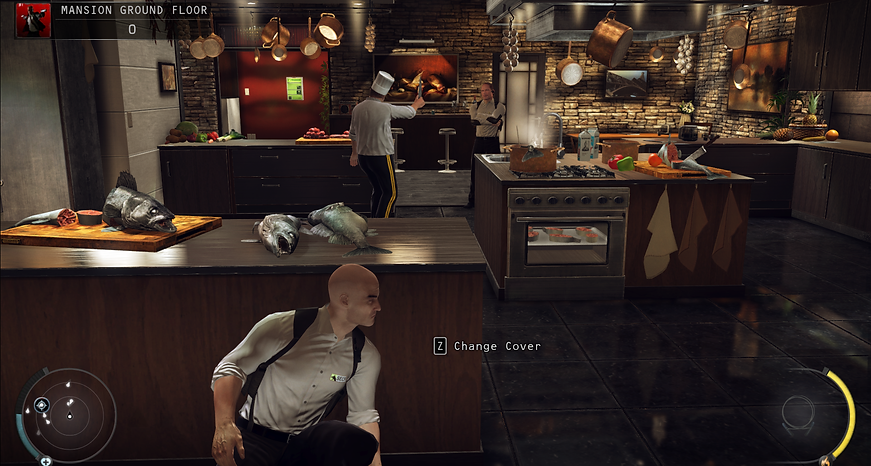
While playing Hitman for the first time, I was intrigued by how naturally the guards reacted to suspicious events. For a class assignment on behaviour trees, I decided to design a flowchart inspired by the game's AI.
The tree covers key decision-making moments like:
-
Investigating noises
-
Responding to dead or unconscious bodies
-
Guarding a VIP
-
Patrolling freely when idle
Each branch is structured using selectors and sequences to mimic realistic NPC behavior. This helped me to understand how the AI systems work and are implemented in a game.
.png)
Yellow - Root
Blue - Composites
Orange - Conditionals
Green - Actions

The Behaviour tree consists of a Main root and a main Selector (Composite) which branches out to three main Conditionals. It follows the top->down and left->right approach. As the selector is the main composite, the AI moves to next conditional only if the before branch returns false (EG: Only if (Heard a noise?) returns false the AI moves to the other two conditionals.
-
The First Conditional (Hear a noise?) checks for a noise and if a noise is heard by the AI, it enters the branch of Sequence (Composite). The AI performs all the listed actions in order. Looks around and sets an Investigation location to Investigate by moving to the Location. If something abnormal such as a weapon or a dead body is found it moves to sequence which notifies the guards and then moves to search for the suspect.
-
The Second Conditional (Discovered Dead/Unconscious body?) starts its check if the AI identifies a dead/unconscious body during free roam. If a body is found it enters a sequence to look around and investigate. If it encounters or suspects someone to be the suspect it interacts and if suspect is confirmed, it attacks.
-
The Third Conditional is to check for tasks assigned. If a task is not assigned it enters a Selector node which branches to check if a VIP is nearby. If the VIP is nearby, the AI will guard the VIP else it moves to free roam state and wanders around the map.
-
As the third conditional is a Selector, when the wander around action returns true the main selector node becomes true and the AI keeps wandering around until a (Hear a noise? Or Discovered Dead/Unconscious body?) conditional is activated.
GAME: Hitman (2016 Version)
Character Critical Analysis
Apex Legends - Octane (Stim Ability)
As part of developing my understanding of system design, I chose to critically analyze an existing, well-balanced ability from a AAA title. I selected Octane’s Stim Ability from Apex Legends because it combines multiple gameplay systems.



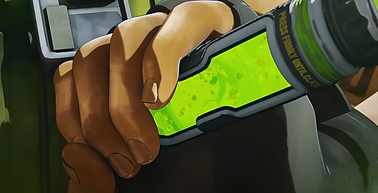
Game mechanics massively involves physics and there cannot be anything better than turning your character into a high-speed sprinter. When a button is pressed (a syringe is injected), this mechanic increases the velocity of the player for a certain amount of time and in turn reduces the player’s health overtime. Specific Sound FX, animations and particles are set with the mechanic to make it more realistic. This ability can be used to get away from the enemies, heal and catch them off guard.
Mechanic Timer Length: 15 Seconds
Health: -2/Second
Velocity: Normal x 2


PSEUDOCODE
Set timer to 0
Press the Stim ability button
Check if Stim ability is available (or on cool down)
If (No)
Print and display the Cool down timer
Lock the stim ability button until cool down
If (yes)
Activate the stim ability
Change the velocity x 2
Decrement the Health – 2/Second
Play Stim Sound FX (normal x 2)
Play Stim Animation
Play Stim Particles
After timer is 15
(Velocity x 2)/ 2
Increment the Health +2/Second
Play Stim End Sound FX
Play Stim End Particles
Play Stim End Animation
Start Cooldown timer
Reset the timer

Explore




